Marketing
Grain quality requirements
Markets require both consistent quality and quantity of lentils.
| Type | Quality characteristics | Comments |
|---|---|---|
| Red lentils | Seed size, absence of seed coat blemishes or poor colour of splits, seed coat colour | Seed size is important for markets (small, medium and large). Seed coat colour is less important, but it must be virtually free of blemishes and be uniform in size and colour. A grey-brown to red seed coat is most common, with dark (red-orange) coloured splits preferable to a lighter (yellow-red) colour. Poor seed coat colour may be caused by disease, weather staining, delayed harvest or frost, which may also affect quality. Green cotyledon discolouration is caused by premature ripening |
| Use | Red lentils are mainly consumed as splits or dehulled (footballs). Rounder shaped grain is preferred for improved splitting efficiency. Cereal, vetch or lentil seed from another variety are major contaminants of lentils. Insect attack at podding downgrades grain quality | |
| Green lentils | Seed size, absence of seed coat blemishes, seed coat colour | Green lentils are mainly used for whole consumption so grain must be blemish free and of a consistent colour and size. Market preference for certain varieties is based on seed colour (paleness of green) and seed size |
| Optimal seed size will depend on variety | Larger sized green lentils tend to be preferred as they are more competitive with overseas varieties on export markets. Grain that is not blemished, split, chipped or damaged by insects is important for quality |

Helicoverpa damage (top); Etiella damage (bottom).
C Palmer
 Skip to main content
Skip to main content